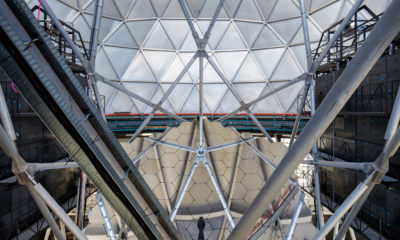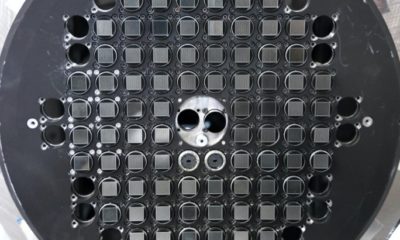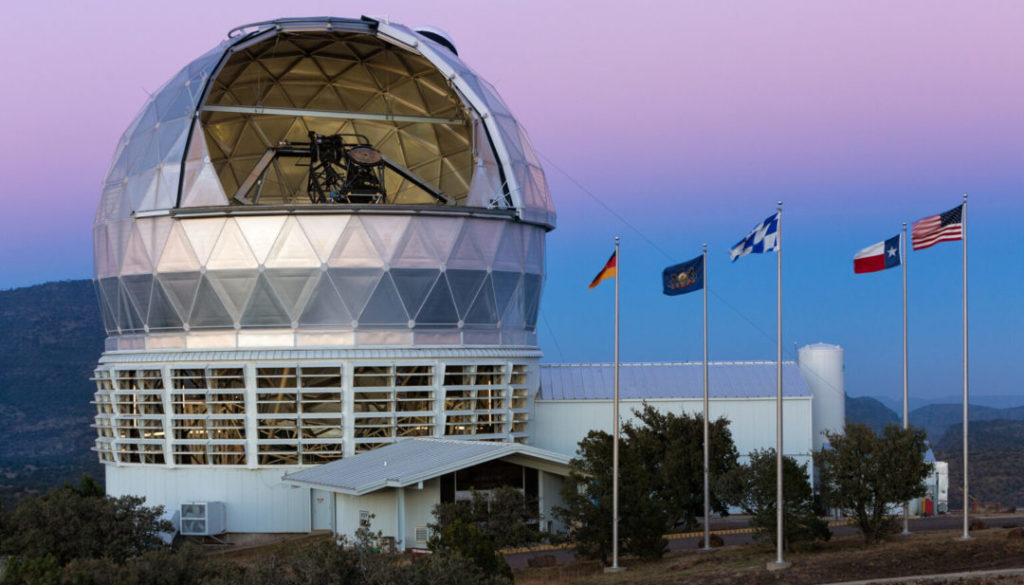HETDEX Project on Track to Probe Dark Energy
Three years into its quest to reveal the nature of dark energy, the Hobby-Eberly Telescope Dark Energy Experiment (HETDEX) led by The University of Texas at Austin and involving Texas A&M University is on track to complete the largest map of the cosmos ever — a three-dimensional map of 2.5 million galaxies that will help astronomers understand how and why the expansion of the universe is speeding up over time.
“HETDEX represents the coming together of many astronomers and institutions to conduct the first major study of how dark energy changes over time,” said Taft Armandroff, Director of The University of Texas at Austin’s McDonald Observatory.

The survey began in January 2017 on the 10-meter Hobby-Eberly Telescope (HET) at McDonald Observatory. Today, the survey is 38% complete. Data reduction and analysis are continuing.
“HETDEX has arrived,” said University of Texas astronomer Karl Gebhardt. “We’re over a third of the way through our program now, and we have this fantastic dataset that we’re going to use to measure the dark energy evolution.”
The survey works by aiming the telescope at two regions of the sky near the Big Dipper and Orion. For each pointing, the telescope records around 32,000 spectra, capturing the cosmic fingerprint of the light from every object within the telescope’s field of view.
“It’s actually a little mind-blowing, how much information is captured in this,” said University of Texas astronomer and team member Gary Hill.
These spectra are recorded via 32,000 optical fibers that feed into more than 100 instruments working together as one. This assembly is called VIRUS, the Visible Integral-field Replicable Unit Spectrograph. It’s a massive machine made up of dozens of copies of an instrument working together for efficiency.
Designed by Hill and built especially for HETDEX, the first-of-its-kind VIRUS instrument was assembled and aligned in Texas A&M’s Charles R. ’62 and Judith G. Munnerlyn Astronomical Laboratory under the direction of Texas A&M astronomer Darren DePoy, holder of the Rachal-Mitchell-Heep Endowed Professorship in Physics in the Texas A&M Department of Physics and Astronomy and member of the George P. and Cynthia Woods Mitchell Institute for Fundamental Physics and Astronomy. DePoy spearheaded the challenging construction of no fewer than 192 individual VIRUS units — each an identical copy of a single spectrograph, and each containing a bundle of about 230 optical fibers individually designed to focus on a tiny piece of the sky — as well as the assembly and testing of the overall instrument along with fellow Texas A&M astronomer Dr. Jennifer Marshall.
Watch a 2014 video featuring Texas A&M astronomers discussing VIRUS as installation was underway on the Hobby-Eberly Telescope at McDonald Observatory:
DePoy notes the VIRUS concept is a first in astronomy, not only in terms of its function in the revolutionary HETDEX project but also its utilization of industrial replication, which he estimates saved about 75 percent of the cost that would have been required to build a single spectrograph big enough to do the job. To date, VIRUS is but one of several complex instrumentation-related projects either completed or underway within the Munnerlyn Lab for use in a host of international experiments, from the first-light GMACS instrument and actuators for the Giant Magellan Telescope, to spectrophotometric calibration systems that enabled the unprecedentedly precise photometric measurements produced by the Dark Energy Survey, to science case strategy and technical specifications for the Maunakea Spectroscopic Explorer.

“We are fortunate at Texas A&M to have both the excellent students and staff as well as the high-quality lab space required to build such precision instrumentation,” said DePoy, who also serves as associate dean for research in the Texas A&M College of Science. “All of us are excited to be part of such a groundbreaking project as VIRUS and HETDEX.”
Building one of the most advanced astronomical instruments in the world “was quite a task to orchestrate,” Hill said, noting that the project has taken a decade to reach fruition. “It’s the largest on many measures,” he said, noting that it has the most optical fibers, as well as having as much detector area as the largest astronomical cameras. It’s also an extremely large instrument, taking up much of the room inside the telescope dome.
HETDEX is a blind survey, meaning that rather than pointing at specific targets, it records everything over a specific patch of sky. Then scientists go back through to the data later to sift out specific objects they want to study.
To make the map needed for the dark energy project, HETDEX team members are combing through a billion spectra, looking for examples of a specific type of galaxy. These galaxies range in distances from 10 billion to 11.7 billion light-years away, so they represent an epoch when the universe was only a few billion years old. Their spectra carry information about how fast the galaxies are moving away from us as a result of the expansion of the universe. That will allow astronomers to determine how the rate at which the universe expands has changed over the eons, which is key to determining the nature of dark energy.
The HETDEX team expects to complete their observations by December 2023. In total, the completed survey will include one billion spectra, “the largest ever spectral survey by far,” Gebhardt said. These data are processed and stored at UT Austin’s Texas Advanced Computing Center (TACC), one of the top supercomputing centers in the world.
HETDEX is a large international collaboration. The project is led by The University of Texas at Austin McDonald Observatory and Department of Astronomy with participation from Penn State University; Ludwig Maximilians University, Munich; the Max Planck Institute for Extraterrestrial Physics; the Institute for Astrophysics, Gottingen; the Leibniz Institute for Astrophysics, Potsdam; Texas A&M University; The University of Oxford; the Max Planck Institute for Astrophysics; The University of Tokyo; and the Missouri University of Science and Technology.
In addition to Institutional support, HETDEX is funded by the National Science Foundation (grant AST-0926815), the State of Texas, the US Air Force (AFRL FA9451-04-2-0355), and generous support from private individuals and foundations.
Find additional images and animations, courtesy of The University of Texas at Austin’s McDonald Observatory.
See photographs of VIRUS being assembled and aligned at Texas A&M University, then later transported to and installed at McDonald Observatory.
# # # # # # # # # #
About Research at Texas A&M University: As one of the world’s leading research institutions, Texas A&M is at the forefront in making significant contributions to scholarship and discovery, including in science and technology. Research conducted at Texas A&M generated annual expenditures of more than $952 million in fiscal year 2019. Texas A&M ranked in the top 20 of the most recent National Science Foundation Higher Education Research and Development survey based on expenditures of more than $922 million in fiscal year 2018. Texas A&M’s research creates new knowledge that provides basic, fundamental and applied contributions resulting, in many cases, in economic benefits to the state, nation and world. To learn more, visit Research@Texas A&M.
-aTm-
Contact: Shana K. Hutchins, (979) 862-1237 or shutchins@science.tamu.edu or Dr. Darren L. DePoy, (979) 862-2082 or depoy@physics.tamu.edu
The post HETDEX Project on Track to Probe Dark Energy appeared first on Texas A&M College of Science.
